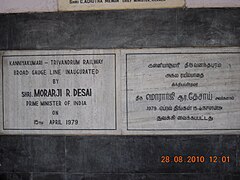Nagercoil Junction railway station
Nagercoil Junction Nagerkovil Junction | |
|---|---|
 Main building of the station | |
| General information | |
| Location | Railway Feeder Rd, Kottar, Nagercoil. PIN – 629 002, Kanyakumari, Tamil Nadu India |
| Coordinates | 8°10′26″N 77°26′38″E / 8.174°N 77.444°E |
| Elevation | 38 metres (125 ft) |
| Owned by | Ministry of Railways (India) |
| Operated by | Indian Railways |
| Line(s) | |
| Platforms | 4 Side platforms[1] |
| Tracks | 12 |
| Connections | Auto, Taxi stand, Bus stand |
| Construction | |
| Structure type | At–grade |
| Parking | Available |
| Accessible | |
| Other information | |
| Status | Functioning |
| Station code | NCJ[2] |
| Zone(s) | Southern Railway zone |
| Division(s) | Thiruvananthapuram |
| History | |
| Opened | 17 April 1979 |
| Electrified | 25 kV AC 50 Hz |
| Passengers | |
| 2018–19 | 8,318 per day[3] |
| Rank | 9 (in Tamil Nadu) 6 (in Trivandrum division) |
Nagercoil Junction railway station (station code: NCJ[2]) is an NSG–3 category Indian railway station in Thiruvananthapuram railway division of Southern Railway zone.[4] It is a railway junction in Kanyakumari district in the state of Tamil Nadu.
Background[edit]
Trivandrum–Nagercoil–Kanniyakumari and Tirunelveli–Nagercoil construction projects were inaugurated by the then Prime minister Mrs.Indira Gandhi on 6 September 1972. The Trivandrum–Nagercoil–Kanniyakumari line was opened on 15 April 1979. Nagercoil Junction became operational on 15 April 1979. The rail-link to Kanniyakumari was established only in 1979, mainly because establishing a rail line through the district posed some challenges for the rail department and took a lot of efforts, especially the western line. The western line runs through some huge artificial ground-elevations and a number of hill-tunnels. Kanyakumari district is connected through direct train services with all leading metropolitan cities in India like New Delhi, Mumbai, Chennai and Kolkata. The Chennai–Nagercoil sector is the largest profit making line in south India, which brought in ₹346 crore (US$43 million) in 2011.[5] Most of the train services from this station were the trains, that were extended services from nearest major cities such as Tirunelveli Junction and Thiruvananthapuram Central.
Layout[edit]
The station has four platforms (6 PFs Post doubling) connecting the Kanyakumari–Trivandrum line (West Coast Line) of the Thiruvananthapuram railway division to the Chennai– Madurai–Nagercoil line [6]
-
Foundation stone
-
Placard of inaugural function
Lines[edit]
- Fully Electrified Single BG Line Towards Tirunelveli (Doubling are working in progress)
- Fully Electrified Single BG Line Towards Trivandrum (Doubling are working in progress)
- Fully Electrified single BG Line Towards Kanniyakumari ( Doubling are working in progress )
Projects and development[edit]
It is one of the 73 stations in Tamil Nadu to be named for upgradation under Amrit Bharat Station Scheme of Indian Railways.[7]
See also[edit]
References[edit]
- ^ "54 Departures from Nagercoil SR/Southern Zone - Railway Enquiry". indiarailinfo.com. Retrieved 30 March 2024.
- ^ a b "Station Code Index" (PDF). Portal of Indian Railways. Centre For Railway Information Systems. 2023–24. p. 7. Archived from the original (PDF) on 16 February 2024. Retrieved 27 March 2024.
- ^ "Annual originating passengers & earnings for the year 2018-19" (PDF). Southern Railways. Retrieved 8 July 2019.
- ^ "SOUTHERN RAILWAY LIST OF STATIONS AS ON 01.04.2023 (CATEGORY- WISE)" (PDF). Portal of Indian Railways. Centre For Railway Information Systems. 1 April 2023. p. 3. Archived from the original (PDF) on 23 March 2024. Retrieved 27 March 2024.
- ^ "Chennai-Kanyakumari section emerges most profitable for third year running"
- ^ "XI LOK SABHA DEBATES Session II, Budget Thursday, 25 July 1996/Sravana 3, 1918 (Saka)". Archived from the original on 4 March 2016. Retrieved 3 October 2012.
- ^ "AMRIT BHARAT STATIONS". Press Information Bureau. New Delhi. 10 February 2023. Retrieved 6 April 2024.




